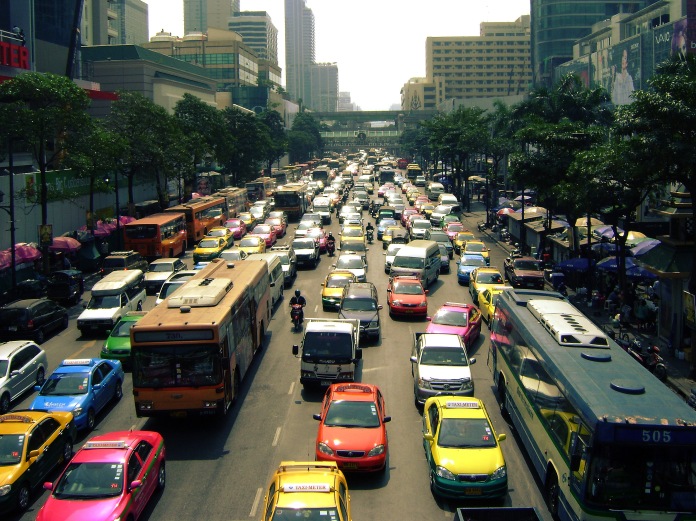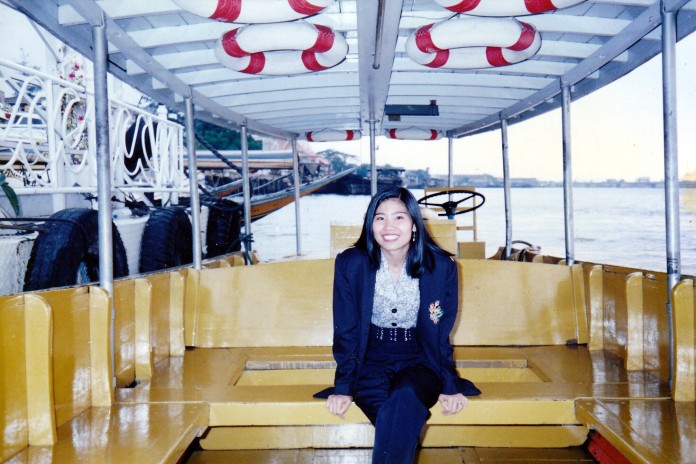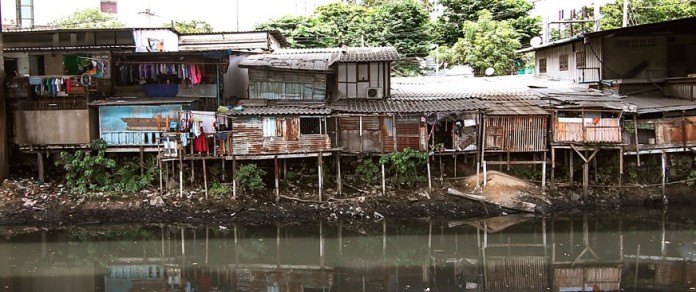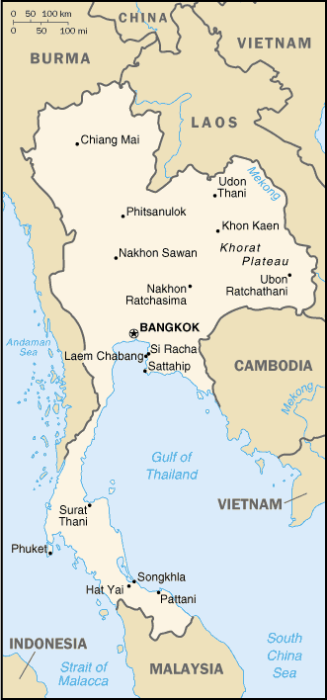Author’s Note: In 1993, during the peak years of the HIV/AIDS epidemic in Thailand, I planned and conducted an independent investigation on child abandonment and HIV/AIDS in northern Thailand, as part of my doctoral program at School of Public Health, University of Hawaii at Manoa, with support from the East-West Center research institute in Honolulu, USA, UNICEF Thailand, and Mahidol University School of Public Health in Bangkok.
The fieldwork incorporated epidemiological and anthropological methods as well as participatory urban and rural appraisal techniques over a nine-month period. I applied computerized data analysis to assess the nature and magnitude of problems within a context of rapid social and economic change, and proposed options for prevention and community based management of abandoned children. The findings were published in a major collaborative study to assist national and regional planning and policy development.
Chiang Mai
Across from Central Shopping Complex, my apartment in Chiang Mai, Thailand’s second largest city, was new and comfortable. The rent was cheap, the building was clean and a public pool was just a short walk away – through choking, dust-filled, traffic snarls.
It also happened to be home to a host of local ‘kept’ women – the ‘minor wives’ (mia noi) of wealthy Thais, their Mercedes and BMWs regularly arriving to pick up and drop off these beautiful women, in some instances with small children – comprising ‘second families.’
My other hangout was a health station on the outskirts of the city where I was hosted by a community health nurse and her son in a peaceful, rural setting, but within a short pickup truck ride to the city. As with many of the peri-urban districts near Chiang Mai, ours had been hit hard with HIV/AIDS and was therefore one of my primary data collection sites.

Almost daily, and for months, local funeral processions made their way to the crematorium directly across the road from our health station. The men were dying from AIDS, and tragically, it would only a matter of time before their wives and girlfriends would follow.
In one neighboring sub-district, fully 30% of pregnant women had tested positive for HIV. These women, as so many others like them, had been infected with HIV by their only sex partner – their husband. Widespread unprotected sex in the many commercial sex venues frequented by single and married Thai men, was the principle driver of the epidemic.
In many cases, the husband was already dead – the child as well, and many of these young housewives would be left utterly alone – rejected by neighbors, friends and family, and unable or unwilling to safely confide in anyone except the local health worker or counselor due to the widespread fear and stigma towards people infected with HIV.
Others, particularly the poor who worked in the widespread commercial sex industry would eventually die as well. Having lifted their families out of poverty – a nice house, perhaps a new pickup truck parked out front – but the daughter (or son) was dead.

It was devastating, and I was forever humbled by the tireless dedication of the many fine individuals in the medical, social welfare and counseling professions – including Yao, the most junior of the eight community health nurses assigned to her health station. She was often the only one who would provide home care for people living with HIV and AIDS, and eventually was the only one who would close the eyes of the deceased.
She also quietly supplied the local ‘gay’ temples with condoms, and tried unsuccessfully to convince the local Abbot – a respected figure and HIV-positive – to ‘come out’ to promote better prevention. Buddhist temples have traditionally taken in young boys as novices, often from poor families wanting a better future for the child, including free education, shelter and financial support. But without proper oversight, sexual abuse has become a reality, both among the older and younger novices as well as between monks and novices.
However, as the epidemic progressed, many Buddhist temples also became important refuges for the HIV-positive homeless – who had been rejected by their families, and hospices for end-of-life care for people living with HIV and AIDS.
Land of Smiles
Back at the apartment in town, my neighbor Bill was seated in the downstairs lounge reading a paperback, his hulking mass squeezed into a lounge chair – waiting, as always for his phone to ring with the next job.
A former coal miner from somewhere in northern England, he now made a living running contraband between various Asian ports. His large, scarred head was covered with sparse patches of brown stubble. He looked up and flashed a cheerful grin through broken teeth.
“Off somewhere?” he asked.
“Headed to the beach for a few days – need a break from this madhouse, dust-ball of a town.” I replied.
“Good idea! I just got back from Japan – I’m set for money now. But while I was gone, me woman and two of her friends hocked the TV and stole me clothes, me money… Bloody headache the damned bitch.”
“Why do you put up with her?” I asked.
“Aw, she’s not a bad girl really. A hell of a lot better than the last one – at least here the girls treat a bloke with some decency. Back in London if I say hi to a girl on the street she’ll tell me to fuck off.”
Orange Crush
My field research in Thailand was winding down, so Yao and I boarded an overnight ‘VIP’ bus in Chiang Mai and headed south to Bangkok, and then to the beach. Out on the open road, the bus charged into the darkness of the night.
The air conditioner was turned too high and the video at the front of the bus was playing so loud it hurt. When I went forward to ask the driver to turn down the volume, a collective sigh of relief followed among the mostly Thai passengers, as if to say “thank goodness that foreigner made the awkward request.” Thais typically avoid confrontation at all cost.
I tried to catch some sleep in the swerving bus as it hurtled through the night, but the headlights of on-coming traffic flashing by seemed much to close for comfort. Vivid scenes of wrecked buses along the roadside – sheered lengthwise – came to mind. Horrible road accidents were common on Thailand’s two lane highways, and the local orange-colored buses were jokingly known as “orange crush.”
Indeed, it was prudent to sit in the middle so as not to be crunched in the front or the rear, and on the opposite side to the on-coming traffic. I was seated in the middle, but on the wrong side and couldn’t sleep for fear of waking up with an oncoming bus in my face.

Pulling into Bangkok’s early morning traffic, the day was already heating up into a stifling haze. The city groaned with the sound of vehicles – a gray urban skyline stretched out before us and disappeared into the haze. Then, crammed into a ‘backpacker special’ minibus for another overnight near-death experience at the hands of a reckless driver – miraculously, we arrived safely in the southern town of Surat Thani.

Stretched out on the smooth salt- and weather-worn deck of a converted fishing boat, we headed to the islands of Samui, Pha-Ngan, and finally to Tao Island (Koh Tao) and soaked up three lovely days of pleasant, breezy walks through coconut groves and jungle-clad mountains, snorkeling in the clear, silky waters decorated with soft and hard corals, brightly colored fish, giant manta rays, diving on a wreck, and enjoying plenty of fresh seafood. It was wonderfully refreshing to finally unwind a bit, and to get rested and healthy again.
Stay tuned for more stories, coming soon!






























Fund the WHO Again? When Hell Freezes Over…
“[World Health Organization director-general, Tedros Adhanom Ghebreyesus], said of the recent US move to cut off the WHO’s funding: ‘I hope the freezing of the funding will be reconsidered and the US will once again support WHO’s work and continue to save lives. I hope the US believes that this is an important investment, not just to help others but for the US to stay safe also.’” – Knowhere, April 22, 2020, WHO chief says virus ‘will be with us for a long time’
Hell to the no!
First, the WHO completely botched the global informational response to this event because they pandered to the disingenuous Chinese where the virus’s expansion potential was concerned. This useful idiot didn’t insist that his team get in there and determine for themselves – based on acquired facts – the severity of the infection. Instead, he accepted numbers on face value from a government that openly manipulates its currency to its advantage and tacitly endorses the pirating of other nations’ intellectual properties.
Second, that ass-hat isn’t even a medical doctor. He’s a corrupt Marxist politician and a member of a recognized terror organization. He belongs to the Tigrayan People’s Liberation Front (TPLF), an Ethiopian group listed in the Global Terrorism Database. He also once named genocidal megalomaniac Robert Mugabe a “goodwill ambassador” from the WHO. That, in and of itself, should disqualify Ghebreyesus from holding any public position anywhere.
Third, he has a disquieting entanglement with the vaccine-happy, population-control minded Bill Gates. According to Johan van Dongen who writes for Modern Ghana, a locale routinely trotted out by WHO officials for propaganda purposes:
“The WHO…should be an independent organization, but for a very large part, it is financed by one person: Bill Gates. The Bill & Melinda Gates Foundation has donated more than $ 2 billion to the WHO since the ‘90s.”
So, not only has Ghebreyesus established himself as a cog of the global elites, he has proved to be inept in the execution of his mission and corrupt in delivering results to the world community. But he wants the United States to resume taxpayer endowments to the tune of 22 percent of their budget; $237 million in assessed “dues” and $656 million in “voluntary contributions” for a two-year period.
If the American people could sue the WHO under the Lemon Law we would stand a great chance of winning. Their product – much like our American media’s product – is defective.
The United States (read: the American people), especially since the end of World War II, has been the world’s slush fund. No matter what the cause or event, the world’s nations and global organizations have come to automatically expect that the United States will give the lion’s share of aid, shaming the American people as “greedy” and “uncompassionate” should we question the purpose, use, or outcome of any international graft.
Like the man or not, President Trump is, in essence, bringing that Lemon Law lawsuit forth in withholding funding from the World Health Organization until they can prove to the American people that they are not funding an inept, corrupt, inefficient, and unreliable global organization that seeks to place mandates on our free people.
Resume funding the WHO? Only if it’s Townsend and Daltrey. At least then we might get some good music out of it.